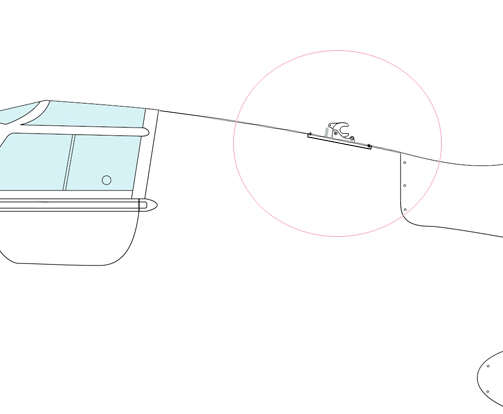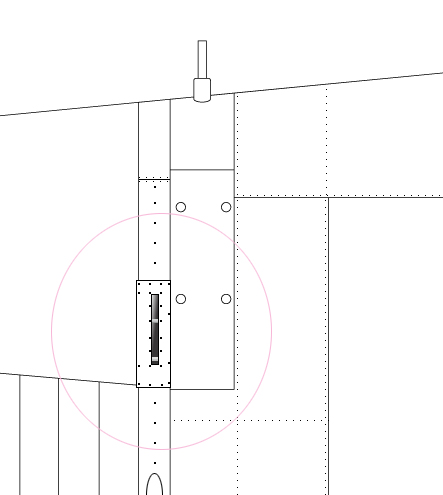

Join us for a look at the new discoveries into this most fascinating subject.
The I-16 and the Zveno SPB
Following an examination of V. Lesnitchenko's excellent article on designer Vakhmistrov and his Zveno projects, I had the occasion to look again at the I-16s featuring in this concept. There can be seen in Maslov's outstandingly fine work on the I-16, Armada #2, a reference line drawing for a Type 24 SPB version of this fighter. I have searched Maslov's text, and to the best of my recollection he does not discuss this version in detail. He seems only to mention that Zavod 207 was supposed to have built or utilized some of these aircraft; of course they never did so. In fact, Zavod 207 managed to deliver only one TB-3 modified to Zveno SPB configuration when the modification/conversion of this type was terminated by Admiral Kuznetsov's order no.00155 (6/40).
As a result, I have the suspicion that this aircraft, an SPB based on the Type 24, was in fact merely a proposal. It could of course be that Maslov has in his collection other documents or photographs demonstrating the contrary. Minus these additional data, however, the examination of all available photographs of SPB I-16s reveal that these are--without exception-- Type 5s; indeed of the original configuration (not the 1938 model). This observation includes several photographs of operational SPB sorties in 1941-42; each is without any question whatsoever a 'standard' Type 5.
With the absolute maximum respect to M. Maslov, I would like to humbly suggest that, perhaps, it would have been wise to clarify this matter in the Armada book. A line drawing, seemingly of competent detail, will of course tend to propagate throughout the historical and aviation modeling communities. I believe that we have already seen a kit of the "Type 24 SPB" in 1:72. It would be unhappy, indeed, if it should transpire that no such version existed. Based on current evidence, this would actually seem to be the case.
In any event, until better information becomes available, all SPB I-16s should be completed as Type 5s. The I-16SPB's mounting items are shown below.


Aviation Aerolacquer AEh-8
Those following the Forum on this site are surely familiar with the various discussions that have taken place regarding the appearance of aerolak AEh-8. A new development has been seen in this story, and it is prudent to discuss it here.
In the course of the writing of M. Maslov's superb book on the Tupolev SB, the redoubtable researcher happened upon the TU (technical specification) for the aviation finish AEh-8. The TU states, clearly, that the finish was a grey lacquer (based seemingly on the myriad of pigments which never materialized in the wood priming series) which contained 10% aluminum powder. Maslov, himself, probably reacting to this information, has taken to describing the paint as "silver-grey" in that volume.
Well, before the various proponents of the euphemistic "dull silver" idea all conjoin to engage in handsprings and public celebrations or recrimination, allow us to review once again the factual evidence of this case. Firstly, there are several quite similar grey coloured French aviation lacquers of the 1930-40 period which contain up to 18% aluminum powder (i.e. twice as much as AEh-8), and none of these feature a "silver" appearance whatever. One cannot see any additional reflectivity or "silver" colouration in these finishes which would betray their very high levels of aluminum powder content. ALG-1 primer also contains 6% aluminum powder, and exhibits no visual signs of such colouration nor properties of any description.
Secondly, and most importantly, there exist today three known samples of actual AEh-8 lacquer. Two of these samples are in my own collection. The third has been compared to these directly, and in my presence. In all three cases the samples of AEh-8 are identical. In no case can there be seen any hint whatsoever of "silver" colouration, enhanced reflectivity, or any other feature associated with a description of this type. However, it was also observed that all three samples were taken from fabric areas (one from fuselage fabric, one from an aileron, one from a rudder), and also that all three have been applied over a coat of 17-A clear dope.
Looking to the existing photographic record of SBs and UTs (and many other aircraft) known to be finished with this lacquer, there is also no evidence in any image of such "silver" features, nor enhanced reflectivity. However, the colour chip located in the 1948 GKhI booklet shows a paint with apparently some visual features of "silver" colouration and/or reflectivity. The disagreement between these sources of information cannot at this time be explained. It seems to me the most reasonable practice that physical evidence from a known example is of greater value than an example chip in a non-period technical book. It is hard to estimate, for example, where a sample of AEh-8 might be found in 1948, noting that the finish went out of manufacture nine years prior to that date. It is also significant that all other forms of evidence, no matter how admittedly limited (i.e. photography, etc), also concur very well with the properties of the physical samples.
Investigation on this point will have to continue. It is not known what effects
the presence of 17-A lacquer might have had on these samples, although there
is no other known change to have occurred to any other Soviet lacquer when so
painted. The specific weathering patterns of fabric areas of the structure are
already under analysis. It is also remotely possible that the sample in the
GKhI booklet was contaminated in some way. The most immediate observation about
this book's colour chip is simply that it might well be wrong. There are other
samples in this book which are demonstrably at odds with the surviving physical
evidence, which certainly would tend to erode one's confidence in this work.
VIAM B3
For many years researchers have encountered this 'finish' in their archival work, and systematically failed to locate physical samples of it. This was true even in cases where we expected to see it, as described by factory or Government documentation. Perhaps as a result, a certain amount of speculation entered the work of aviation authors which perhaps should not have. Alas, this situation affected my own work, as well.
I suppose B3 was not found because no one was looking for the actual material-- it was right in front of our eyes, unseen by virtue of the fact that it was unexpected. It turns out that VIAM B3 was not an aviation finish-- that is to say, lacquer. It was a type of penetrative resin-glue. It is routinely described in some maintenance literature as "B3 klej", or 'glue'; however we all managed to ignore this clue is a classic matter of self-reference-- that is to say, one tends to see what one expects, often at the expense of what is actually present. Perhaps, as well, this fact was exacerbated by the NKAP's recommendations, which routinely state implicitly that B3 could be used as a "finish" to various surfaces. To employ a glue in this way seems particularly daft, actually, until one realizes that this recommendation was made in references to surfaces where putty and sanding would then be applied, additionally. In such a case, painting could proceed quite normally (it is exceedingly typical to find Soviet aviation lacquers applied over putty without further priming).
No doubt, the nature of B3 was thrown into further confusion when the various Bureaux who were using the product insisted to apply glossy red paint over their prototypes. This was done entirely without Government sanction; the agreed development documents (for the I-26 and I-301, for example) state that the wooden surfaces were supposed to be VIAM B3 only. But, as we have seen by far too many times, the factories were usually not overly interested in such documents, and generally proceeded as they thought best. No doubt the surface with red paint was much lower drag than plain B3 would have been, giving better performance figures. Interestingly, however, no mention was made of this painting in any case, not even by the testing fraternities. Apparently, this kind of painting was either regarded as too typical for comment, or the testing community regarded an unfinished B3 surface to be... well, unfinished.
Four samples of authentic VIAM B3 are currently under investigation. Their actual appearance on a wooden surface will be described shortly on this site.
Just as a mention, the ramifications of this discovery are limited mainly to
prototypes. Thus, the I-301 as described by myself is incorrect in that the
surface in view is not B3, but rather some kind of red (or, it could
even be somewhat dark or maroonish) paint. Similarly, the I-26's wooden areas
(wings and tail, basically) were by all means finished with B3, only then to
be over-painted with red (of some kind). This would tend to suggest (not require,
however) a uniform colouration on the aircraft surface.
Caution: Pilot Attributation
As has been mentioned elsewhere on the Forum, and so forth, the matter of attributing pilots to various specific aircraft has been undergoing a severe transformation of late. This work will-- no doubt-- not only continue, but also will probably accelerate as additional material is collected. Many such attributations which have stood for years will fall away and be discarded.
As a result, allow me to reiterate my warning that we must all treat such pilot attributations with the greatest circumspection. 'Definitive' attributations should generally be avoided; it is far better to portray these as suggestions or notions. This matter also extends to the identification of famous aircraft types. Many are familiar with some of the classic errors of this variety, for example placing Kozhedub's "White 14" markings onto an La-5FN when, in fact, the machine was an La-5F. Well, let me assure one and all that this is the tip of the iceberg....
A comprehensive review of all published aviation photographs depicting VVS aircraft is underway. I am hopeful that the result of this work will be a number of CD-Roms with profile artwork and analysis. Even at this stage, there have already been made some discoveries which I am certain will cause shock and perhaps alarm. One of these was discussed elsewhere regarding Stepanenko's "White 17", which is in fact a Yak-7B, not a -9 as everyone (including myself) has depicted hitherto. Many more such errors will be examined, on aircraft with an even higher public profile. The results will be fascinating, to say the least.